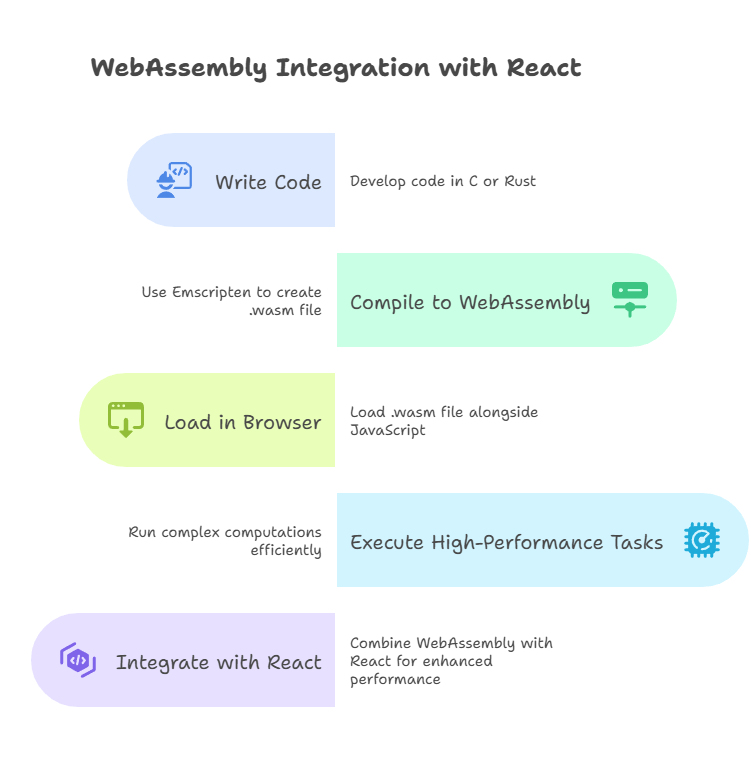WebAssembly Integration in React
WebAssembly (Wasm) is a binary instruction format for a stack-based virtual machine, designed to be a portable target for compiling high-level languages like C, C++, and Rust. This allows web browsers to execute code at near-native speed, enabling complex computations in web applications.React, a popular JavaScript library, is used for building user interfaces. Integrating WebAssembly with React allows for high-performance web applications, especially where JavaScript alone might struggle with performance, such as for game engines, graphics, or scientific simulations.
Basics
What is WebAssembly?
WebAssembly is a low-level assembly-like language designed to run alongside JavaScript in modern web browsers. It enables fast execution of complex computations, making it perfect for tasks like image processing, games, and other CPU-intensive applications.
Key features:
- Binary format: WebAssembly files (
.wasm) are compiled and executed in a compact binary format that browsers can run efficiently. - Security: Runs in a sandboxed environment, preventing access to sensitive resources.
- Cross-browser support: Supported by all modern browsers (Chrome, Firefox, Edge, Safari).
How WebAssembly Works:
- You write code in a language like C or Rust.
- The code is compiled to WebAssembly, creating a
.wasmfile. - The
.wasmfile is loaded in the browser alongside JavaScript, enabling high-performance execution.
Why Integrate WebAssembly with React?
React is a powerful framework for building web applications, but it is limited by JavaScript’s performance. When computations become heavy (e.g., large datasets, image manipulation, physics engines), JavaScript struggles to keep up. This is where WebAssembly excels.
Advantages of Integrating WebAssembly with React:
- Performance: Near-native performance for heavy computations.
- Portability: Code written in languages like C, C++, and Rust can be compiled into WebAssembly and used in the web.
- Scalability: Allows you to handle resource-intensive tasks without overloading JavaScript.
Compiling to WebAssembly (Wasm)
To integrate WebAssembly with React, you first need to compile your code into WebAssembly. Let’s take a small C++ program as an example.
Example C++ Code:
// hello.cpp
extern "C" {
int add(int a, int b) {
return a + b;
}
}
Here’s what happens in this code:
- The
extern "C"makes sure the compiled function has the correct symbol format, allowing it to be called from JavaScript or React.
Steps to Compile to WebAssembly:
- Install Emscripten, a compiler toolchain that compiles C and C++ code to WebAssembly.
- Compile the code using the following command:
emcc hello.cpp -s WASM=1 -o hello.js
- This will generate two files:
hello.wasmandhello.js.

How React and WebAssembly Communicate
To communicate between React (JavaScript) and WebAssembly, you use JavaScript’s WebAssembly API. WebAssembly modules are loaded using JavaScript, and functions inside the .wasm file can be called like regular JavaScript functions.
Here’s the basic structure:
- WebAssembly Instance: Created by loading the
.wasmfile. - JavaScript/React bridge: Allows data transfer between React components and WebAssembly functions.
async function loadWasm() {
const response = await fetch('hello.wasm');
const buffer = await response.arrayBuffer();
const wasmModule = await WebAssembly.instantiate(buffer);
return wasmModule.instance;
}
Calling WebAssembly Functions from React
Once WebAssembly is loaded, you can call its functions in React components.
Example:
Calling WebAssembly Functions from React
Once WebAssembly is loaded, you can call its functions in React components.
Example:
import React, { useEffect, useState } from 'react';
function AddComponent() {
const [result, setResult] = useState(null);
useEffect(() => {
async function loadWasmAndCallAdd() {
const wasmModule = await loadWasm();
const addResult = wasmModule.exports.add(5, 3); // Call add function
setResult(addResult);
}
loadWasmAndCallAdd();
}, []);
return (
<div>
<p>Result from WebAssembly: {result}</p>
</div>
);
}
export default AddComponent;
Explanation:
- The
loadWasmfunction loads the.wasmfile and initializes it. - The
addfunction, defined in C++, is called from React usingwasmModule.exports.add(5, 3), and the result is displayed in the component
Handling Data Between React and WebAssembly
Data can be transferred between React and WebAssembly through:
- Primitive types (like integers, floats).
- Buffers/Arrays: More complex data structures such as arrays can be passed by using typed arrays (e.g.,
Uint8Array).
For example, passing an array from React to WebAssembly.
const array = new Uint8Array([1, 2, 3, 4]);
wasmModule.exports.processArray(array);
Practical Example: Integrating C++ with React via WebAssembly
Let’s dive into a full example where a WebAssembly function handles complex mathematical computations (e.g., factorial calculation).
extern "C" {
int factorial(int n) {
if (n <= 1) return 1;
return n * factorial(n - 1);
}
}
React Integration:
import React, { useState, useEffect } from 'react';
function FactorialComponent() {
const [number, setNumber] = useState(5);
const [result, setResult] = useState(null);
useEffect(() => {
async function loadAndCalculateFactorial() {
const wasmModule = await loadWasm();
const factorialResult = wasmModule.exports.factorial(number);
setResult(factorialResult);
}
loadAndCalculateFactorial();
}, [number]);
return (
<div>
<p>Factorial of {number} is: {result}</p>
<button onClick={() => setNumber(number + 1)}>Increase</button>
</div>
);
}
export default FactorialComponent;
Advanced Use Cases of WebAssembly in React
- Graphics: WebAssembly can handle complex 3D rendering tasks in React using WebGL.
- Cryptography: Secure hashing and encryption algorithms can run in WebAssembly to improve security.
- Games: Physics engines in games can run efficiently with WebAssembly. Debugging WebAssembly in React
Debugging WebAssembly in React can be challenging, as it involves two languages. Most browsers have built-in WebAssembly debugging tools in their developer consoles. Key strategies include:
- Source maps: Emscripten generates source maps to help debug original C/C++ code.
- Browser tools: Chrome DevTools and Firefox Debugger offer WebAssembly debugging support.
Integrating WebAssembly with React allows for high-performance applications by enabling JavaScript to offload heavy computation to WebAssembly. This opens up opportunities for building fast and scalable web applications in fields like games, graphics, and scientific computing. By understanding how to compile and use WebAssembly within React, developers can leverage the best of both worlds—React’s powerful UI framework with WebAssembly’s performance capabilities. Happy coding !❤️
